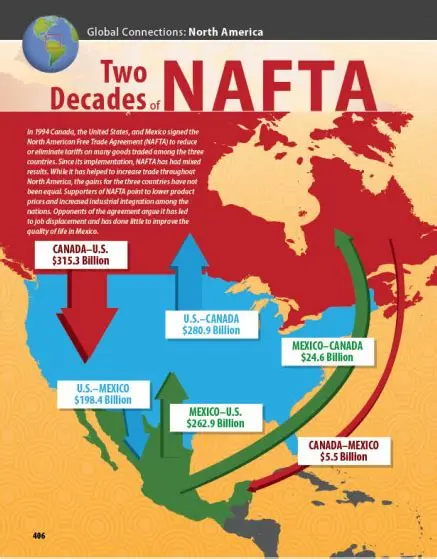The North American Free Trade Agreement (NAFTA) was established in 1994 as a trade agreement between the United States, Canada, and Mexico. This groundbreaking pact aimed to eliminate barriers to trade and investment among the participating countries, creating the world’s largest free trade area at the time. Over the years, NAFTA has had a profound impact on the economies of all three countries, influencing various aspects of their economic landscapes.
One of the most significant effects of NAFTA was the surge in trade among the participating countries, leading to increased economic integration and cross-border business activities. This unprecedented growth in trade not only bolstered the economies of all three nations but also had a substantial impact on employment patterns, industries, and overall economic development. In this blog post, we will delve into the ways in which NAFTA influenced the participating countries’ economies, examining the increased trade, employment impact, effect on industries, and the overall economic growth and development resulting from this historic trade agreement.
Introduction to NAFTA
North American Free Trade Agreement (NAFTA) was established to promote trade and economic cooperation between the United States, Canada, and Mexico. It came into effect on January 1, 1994, and has had a significant impact on the economic landscape of the participating countries. The agreement aimed to eliminate tariffs and other trade barriers, streamline trade regulations, and facilitate investment among the member countries. By promoting free trade, NAFTA sought to boost economic growth, create jobs, and enhance the competitiveness of North American industries in the global market.
One of the key objectives of NAFTA was to create a trilateral trade bloc that could compete with other major economic powers. By forging this alliance, the member countries hoped to leverage their collective resources and market potential to attract investment and promote regional economic integration. The agreement also aimed to strengthen diplomatic ties between the participating nations and foster a spirit of cooperation and mutual benefit.
NAFTA represented a landmark in international trade agreements and served as a model for future regional trade pacts. It set a precedent for the removal of trade barriers and the integration of diverse economies, paving the way for increased globalization and economic interconnectedness. The implementation of NAFTA marked a significant shift in trade policy and had far-reaching implications for the North American region as a whole.
In the subsequent subheadings of this blog post series, we will delve deeper into the various aspects of NAFTA and analyze its impact on trade, employment, industries, and economic development in the participating countries.
Increased Trade between the Participating Countries
Increased Trade between the Participating Countries has been one of the most significant outcomes of the North American Free Trade Agreement (NAFTA). The agreement, which was signed in 1994 by the United States, Canada, and Mexico, aimed to eliminate barriers to trade and investment between the member countries. As a result, trade between these nations has flourished, leading to a substantial increase in the flow of goods and services across borders.
This increase in trade has been facilitated by the removal of tariffs and other trade barriers, making it easier for businesses in the participating countries to export and import goods. This has not only benefited large corporations but has also created opportunities for small and medium-sized enterprises to expand their reach and explore new markets.
Moreover, the increased trade has led to a more integrated production process, with companies in different countries collaborating on the manufacturing of goods. This has resulted in the creation of global value chains, where products are made using components and materials from various countries, further boosting trade among the participating nations.
Overall, the Increased Trade between the Participating Countries has had a positive impact on their economies, leading to greater economic growth, job creation, and enhanced competitiveness in the global market.
Impact on Employment in Participating Countries
After the implementation of NAFTA, the impact on employment in the participating countries was significant. The trade agreement aimed to reduce trade barriers and promote economic growth among Canada, Mexico, and the United States. As a result, there was a shift in employment patterns across various industries in these countries.
One of the major impacts of NAFTA on employment was the outsourcing of manufacturing jobs from the United States to Mexico. This led to job losses in the US, particularly in the manufacturing sector. While it created employment opportunities in Mexico, the overall effect on the workforce in the participating countries was varied.
Furthermore, NAFTA also contributed to the restructuring of industries in the participating countries. There was a focus on boosting efficiency and competitiveness, which led to some industries expanding while others downsized. This had a direct impact on employment levels within these industries.
In addition, the trade agreement also influenced the labor market dynamics in terms of job creation and job displacement. Some sectors experienced growth due to increased trade, while others faced challenges in adapting to the new competitive environment. These shifts in employment trends had lasting effects on the workforce in the participating countries.
Effect on Industries in Participating Countries
NAFTA, or the North American Free Trade Agreement, has had a significant impact on the industries in the participating countries – the United States, Canada, and Mexico. The agreement, which went into effect in 1994, aimed to eliminate barriers to trade and investment between the three nations, leading to an increase in economic integration. As a result, many industries in these countries have been affected, both positively and negatively.
One of the main effects of NAFTA on industries in participating countries has been increased competition. With the elimination of tariffs and trade barriers, companies in the US, Canada, and Mexico have had to compete with each other on a larger scale. This has led to some industries becoming more efficient and competitive, while others have struggled to keep up. In particular, industries that were previously protected by trade barriers, such as agriculture and textiles, have been deeply affected by the increased competition.
Additionally, NAFTA has also facilitated the growth of cross-border supply chains, particularly in industries such as automotive and electronics. This has led to increased specialization and efficiency within these industries, as companies can take advantage of the comparative advantages of each country. On the other hand, some argue that this has also led to the outsourcing of jobs and a decline in manufacturing employment in certain industries.
Overall, the impact of NAFTA on industries in the participating countries has been complex and multifaceted. While some industries have benefited from increased market access and lower production costs, others have struggled to compete with the influx of goods from neighboring countries. It is clear that the agreement has fundamentally transformed the industrial landscape of North America, and its effects continue to be felt to this day.
Economic Growth and Development Due to NAFTA
One of the key objectives of the North American Free Trade Agreement (NAFTA) was to promote economic growth and development among the participating countries, namely the United States, Canada, and Mexico. By eliminating tariffs and trade barriers, NAFTA aimed to facilitate the flow of goods, services, and investments between the three nations, ultimately leading to increased economic activity and improved living standards.
With the removal of trade restrictions, businesses were able to expand their operations across various borders, tapping into new markets and reaching a larger consumer base. This not only encouraged innovation and competition but also resulted in job creation and enhanced productivity. As a result, the overall economic growth of the NAFTA countries experienced a positive trend, with an increase in the gross domestic product (GDP) and a boost in trade activities.
Furthermore, the agreement fostered economic development through the establishment of supply chains and the integration of industries. This led to greater specialization and efficiency, allowing each country to focus on its comparative advantage and contribute to the overall growth of the region. In addition, the influx of foreign direct investment (FDI) and technology transfer further supported the expansion and modernization of the participating countries’ economies, paving the way for long-term sustainable development.
In conclusion, NAFTA played a crucial role in promoting economic growth and development among its member nations by fostering trade, stimulating investment, and encouraging innovation. Despite facing criticism and challenges, the agreement undeniably contributed to the overall prosperity and advancement of the North American region, leaving a lasting impact on the participating countries’ economies.
Frequently Asked Questions
What is NAFTA?
NAFTA stands for the North American Free Trade Agreement, which is a trilateral trade bloc between the United States, Canada, and Mexico. It was established to eliminate barriers to trade and investment among the member countries.
How did NAFTA impact trade between participating countries?
NAFTA led to increased trade between the participating countries by eliminating tariffs and other trade barriers, facilitating the flow of goods and services across the borders.
What was the impact of NAFTA on employment in participating countries?
NAFTA had both positive and negative impacts on employment in participating countries. While it led to job creation in certain industries, it also resulted in job losses in others due to increased competition.
How did NAFTA affect industries in participating countries?
NAFTA had a significant impact on industries in participating countries by fostering greater competition, encouraging specialization, and promoting the integration of supply chains across borders.
What were the economic growth and development outcomes due to NAFTA?
NAFTA contributed to the economic growth and development of participating countries by promoting investment, driving innovation, and increasing productivity in various sectors of the economy.
What were some criticisms of NAFTA?
Some criticisms of NAFTA include concerns about the displacement of workers, environmental degradation, and the widening income inequality within and across the member countries.
What is the legacy of NAFTA?
The legacy of NAFTA is characterized by its profound impact on regional integration, the ongoing debates about the benefits and drawbacks of free trade agreements, and the subsequent trade negotiations and agreements that have followed.







